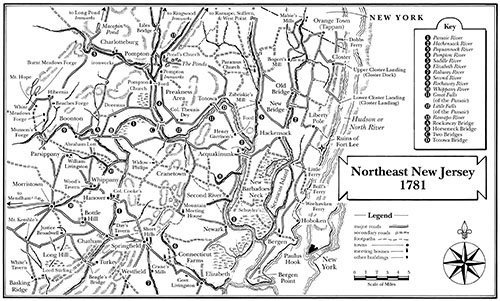Colonel Alexander Scammell to George Washington, 24 May 1781
From Colonel Alexander Scammell
Clarks Town [N.Y.] May 24th 1781.
Sr
I was honor’d with your Letter of the 17tnth The 18tnth in the afternoon.1 I proceeded without delay to Dobbs Ferry leaving orders for the detachment to be form’d at King’s Ferry. Saw Capt. Lawrence the morning of the 19tnth, concerted measures with him. Return’d to the detachment and found the connecticut Troops had but just arrived, and that the whole had no provision, a major part having been destitute two days—I with difficulty obtain’d one days meat from the magazine at Stoney point, & sent a Boat immediately to west point for a supply. march’d that evening below Haverstraw. The next morning reach’d Nyack. My intelligence would not justify a further movement that day. On the Evening of the 21st march’d, and from my Intelligence and the precautions taken had a very great prospect of success. But unfortunately was overtaken by a violent storm of rain which oblidg’d me to put The Troops under cover at Closter—where the incessant rain oblidg’d me to remain all Night. The mens arms being in very bad order the next morning, and the possibility of the enemy’s having receiv’d Intelligence of our movement—Induced me to fall back to the upper part of Tapan towards Clark’s Town holding out an appearance of returning to King’s Ferry. Last Evening I divested my men of their Packs and got under march when I receiv’d Intelligence from a gentleman sent for the purpose that the refugees had abandon’d their works and had fell down with Their Craft opposite to the place where their old block house stood.2 & that a very considerable number of ships lay in the north River above the City. I immediately retir’d to this place—The Refugees it seems had repair’d part of old fort Lee Viz. the west Face, and part of the north & south sides. something in this form.3 They had abbateed the western side and the two ends. and had begun to freize the work.4 The eastern side which was most securely assailable was very incomplete. The militia and yearmen5 are about destroying The work. I am extremely sorry that their unexpected departure prevented my making the 2nd attempt, as I had a very great prospect of success—By information from Capt. Lawrence who was on the spot, and saw several persons who were with the Refugees when the orders came for them to abandon their post. It appears that the Order was very unexpected to Ward & his men, some of whom flew into a violent passion and broke their Guns.6 It is reported that they have taken off six or seven of the worst Tories in the english Neighbourhood, and carried them on bord in irons.7 Various rumors (as is usual on such occasions) prevail’d amongst them. one was That a body of french Troops had landed on the back of Long Island. I have sent a Subaltern with a small reconnoitring party to go down the west side of the River for Intelligence. It is not improbable that the refugees are going to reestablish themselves at their old position. I should be exceeding happy if an Oppo[r]tunity should present for a third attempt. I am very much mortify’d that I have hitherto been prevented from giving them a blow—They are amphibious animals, keep on board their craft by night, and come on shore every morning with great precaution I beg leave to make you my most grateful acknowledgements for honoring me with this Command—and wish to render every service in the power of Yr most respectful, oblidg’d, & Obedt Servt
Alexd. Scammell
P.S. The guard boat left the lower Closter this morning 7 o Clock—No movement of Boats or Ships—By Information from Terry Town, all passing to or from York Island is stop’d. we can procure no late papers from the City—I forgot to mention that Capt. Lawrence is not in service, he has declin’d the state appointment.8
ALS, DLC:GW. GW replied to Scammell on 28 May.
1. See GW to Scammell, 17 May.
2. Scammell refers to the Loyalist blockhouse at Bull’s Ferry, N.J. (see Thomas Lloyd Moore to GW, 22 May 1780, n.3; see also GW to Anthony Wayne, 20 July, and notes 1 and 3 to that document). The Loyalists had abandoned their post at Fort Lee, N.J. (see Jonathan Lawrence, Jr., to GW, 16 May 1781, n.1).
3. At this point in the letter, Scammell drew a vertical rectangle with the line at the top thinner than the lines for the other three sides.

Map 8. Loyalist and American militias renewed raids in the region of the lower Hudson River and northeast New Jersey during May 1781. (Illustrated by Rick Britton. Copyright Rick Britton 2022)
4. Scammel refers to abatis—felled trees with sharpened branches facing the enemy—and fraising, a row of sharpened stakes pointing outward from the earthen wall of a fort or redoubt.
5. Scammell likely refers to militia drafted for one year’s service.
6. Capt. Thomas Ward commanded the Loyalist force at the blockhouse.
7. This action may have been related to Ward’s proposal to switch his allegiance (see Jonathan Lawrence, Jr., to GW, 16 May, and n.3 to that document; see also GW to Lawrence, 17 May).
8. Militia captain Jonathan Lawrence, Jr., soon received a Continental commission (see General Orders, 19 June).

![University of Virginia Press [link will open in a new window] University of Virginia Press](/lib/media/rotunda-white-on-blue.png)
